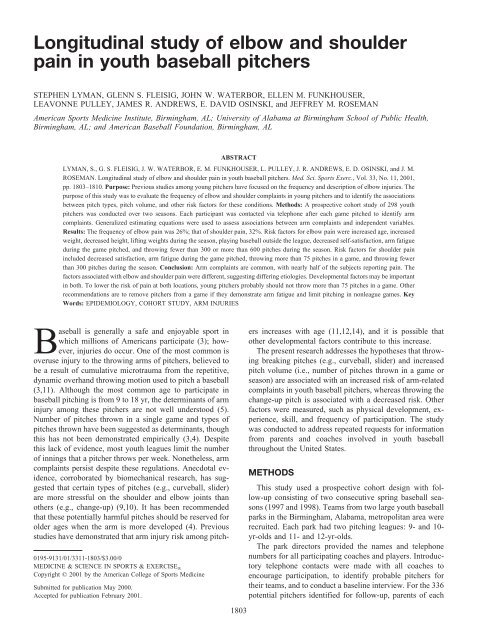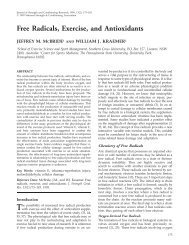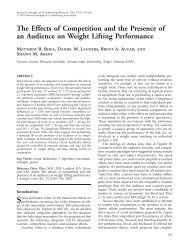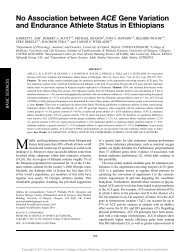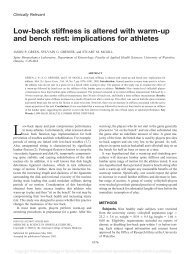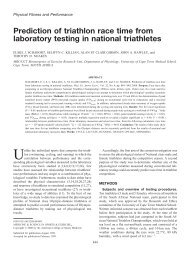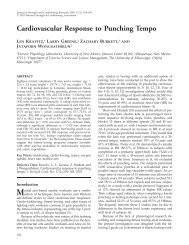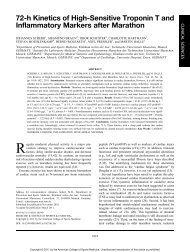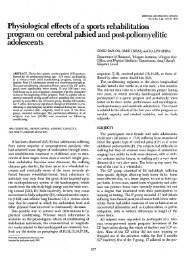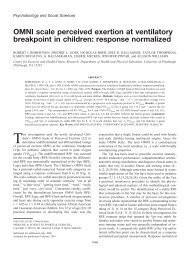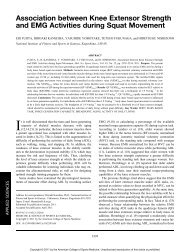Longitudinal study of elbow and shoulder pain in ... - Setanta College
Longitudinal study of elbow and shoulder pain in ... - Setanta College
Longitudinal study of elbow and shoulder pain in ... - Setanta College
Create successful ePaper yourself
Turn your PDF publications into a flip-book with our unique Google optimized e-Paper software.
<strong>Longitud<strong>in</strong>al</strong> <strong>study</strong> <strong>of</strong> <strong>elbow</strong> <strong>and</strong> <strong>shoulder</strong><br />
<strong>pa<strong>in</strong></strong> <strong>in</strong> youth baseball pitchers<br />
STEPHEN LYMAN, GLENN S. FLEISIG, JOHN W. WATERBOR, ELLEN M. FUNKHOUSER,<br />
LEAVONNE PULLEY, JAMES R. ANDREWS, E. DAVID OSINSKI, <strong>and</strong> JEFFREY M. ROSEMAN<br />
American Sports Medic<strong>in</strong>e Institute, Birm<strong>in</strong>gham, AL; University <strong>of</strong> Alabama at Birm<strong>in</strong>gham School <strong>of</strong> Public Health,<br />
Birm<strong>in</strong>gham, AL; <strong>and</strong> American Baseball Foundation, Birm<strong>in</strong>gham, AL<br />
ABSTRACT<br />
LYMAN, S., G. S. FLEISIG, J. W. WATERBOR, E. M. FUNKHOUSER, L. PULLEY, J. R. ANDREWS, E. D. OSINSKI, <strong>and</strong> J. M.<br />
ROSEMAN. <strong>Longitud<strong>in</strong>al</strong> <strong>study</strong> <strong>of</strong> <strong>elbow</strong> <strong>and</strong> <strong>shoulder</strong> <strong>pa<strong>in</strong></strong> <strong>in</strong> youth baseball pitchers. Med. Sci. Sports Exerc., Vol. 33, No. 11, 2001,<br />
pp. 1803–1810. Purpose: Previous studies among young pitchers have focused on the frequency <strong>and</strong> description <strong>of</strong> <strong>elbow</strong> <strong>in</strong>juries. The<br />
purpose <strong>of</strong> this <strong>study</strong> was to evaluate the frequency <strong>of</strong> <strong>elbow</strong> <strong>and</strong> <strong>shoulder</strong> compla<strong>in</strong>ts <strong>in</strong> young pitchers <strong>and</strong> to identify the associations<br />
between pitch types, pitch volume, <strong>and</strong> other risk factors for these conditions. Methods: A prospective cohort <strong>study</strong> <strong>of</strong> 298 youth<br />
pitchers was conducted over two seasons. Each participant was contacted via telephone after each game pitched to identify arm<br />
compla<strong>in</strong>ts. Generalized estimat<strong>in</strong>g equations were used to assess associations between arm compla<strong>in</strong>ts <strong>and</strong> <strong>in</strong>dependent variables.<br />
Results: The frequency <strong>of</strong> <strong>elbow</strong> <strong>pa<strong>in</strong></strong> was 26%; that <strong>of</strong> <strong>shoulder</strong> <strong>pa<strong>in</strong></strong>, 32%. Risk factors for <strong>elbow</strong> <strong>pa<strong>in</strong></strong> were <strong>in</strong>creased age, <strong>in</strong>creased<br />
weight, decreased height, lift<strong>in</strong>g weights dur<strong>in</strong>g the season, play<strong>in</strong>g baseball outside the league, decreased self-satisfaction, arm fatigue<br />
dur<strong>in</strong>g the game pitched, <strong>and</strong> throw<strong>in</strong>g fewer than 300 or more than 600 pitches dur<strong>in</strong>g the season. Risk factors for <strong>shoulder</strong> <strong>pa<strong>in</strong></strong><br />
<strong>in</strong>cluded decreased satisfaction, arm fatigue dur<strong>in</strong>g the game pitched, throw<strong>in</strong>g more than 75 pitches <strong>in</strong> a game, <strong>and</strong> throw<strong>in</strong>g fewer<br />
than 300 pitches dur<strong>in</strong>g the season. Conclusion: Arm compla<strong>in</strong>ts are common, with nearly half <strong>of</strong> the subjects report<strong>in</strong>g <strong>pa<strong>in</strong></strong>. The<br />
factors associated with <strong>elbow</strong> <strong>and</strong> <strong>shoulder</strong> <strong>pa<strong>in</strong></strong> were different, suggest<strong>in</strong>g differ<strong>in</strong>g etiologies. Developmental factors may be important<br />
<strong>in</strong> both. To lower the risk <strong>of</strong> <strong>pa<strong>in</strong></strong> at both locations, young pitchers probably should not throw more than 75 pitches <strong>in</strong> a game. Other<br />
recommendations are to remove pitchers from a game if they demonstrate arm fatigue <strong>and</strong> limit pitch<strong>in</strong>g <strong>in</strong> nonleague games. Key<br />
Words: EPIDEMIOLOGY, COHORT STUDY, ARM INJURIES<br />
Baseball is generally a safe <strong>and</strong> enjoyable sport <strong>in</strong><br />
which millions <strong>of</strong> Americans participate (3); however,<br />
<strong>in</strong>juries do occur. One <strong>of</strong> the most common is<br />
overuse <strong>in</strong>jury to the throw<strong>in</strong>g arms <strong>of</strong> pitchers, believed to<br />
be a result <strong>of</strong> cumulative microtrauma from the repetitive,<br />
dynamic overh<strong>and</strong> throw<strong>in</strong>g motion used to pitch a baseball<br />
(3,11). Although the most common age to participate <strong>in</strong><br />
baseball pitch<strong>in</strong>g is from 9 to 18 yr, the determ<strong>in</strong>ants <strong>of</strong> arm<br />
<strong>in</strong>jury among these pitchers are not well understood (5).<br />
Number <strong>of</strong> pitches thrown <strong>in</strong> a s<strong>in</strong>gle game <strong>and</strong> types <strong>of</strong><br />
pitches thrown have been suggested as determ<strong>in</strong>ants, though<br />
this has not been demonstrated empirically (3,4). Despite<br />
this lack <strong>of</strong> evidence, most youth leagues limit the number<br />
<strong>of</strong> <strong>in</strong>n<strong>in</strong>gs that a pitcher throws per week. Nonetheless, arm<br />
compla<strong>in</strong>ts persist despite these regulations. Anecdotal evidence,<br />
corroborated by biomechanical research, has suggested<br />
that certa<strong>in</strong> types <strong>of</strong> pitches (e.g., curveball, slider)<br />
are more stressful on the <strong>shoulder</strong> <strong>and</strong> <strong>elbow</strong> jo<strong>in</strong>ts than<br />
others (e.g., change-up) (9,10). It has been recommended<br />
that these potentially harmful pitches should be reserved for<br />
older ages when the arm is more developed (4). Previous<br />
studies have demonstrated that arm <strong>in</strong>jury risk among pitch-<br />
0195-9131/01/3311-1803/$3.00/0<br />
MEDICINE & SCIENCE IN SPORTS & EXERCISE ®<br />
Copyright © 2001 by the American <strong>College</strong> <strong>of</strong> Sports Medic<strong>in</strong>e<br />
Submitted for publication May 2000.<br />
Accepted for publication February 2001.<br />
1803<br />
ers <strong>in</strong>creases with age (11,12,14), <strong>and</strong> it is possible that<br />
other developmental factors contribute to this <strong>in</strong>crease.<br />
The present research addresses the hypotheses that throw<strong>in</strong>g<br />
break<strong>in</strong>g pitches (e.g., curveball, slider) <strong>and</strong> <strong>in</strong>creased<br />
pitch volume (i.e., number <strong>of</strong> pitches thrown <strong>in</strong> a game or<br />
season) are associated with an <strong>in</strong>creased risk <strong>of</strong> arm-related<br />
compla<strong>in</strong>ts <strong>in</strong> youth baseball pitchers, whereas throw<strong>in</strong>g the<br />
change-up pitch is associated with a decreased risk. Other<br />
factors were measured, such as physical development, experience,<br />
skill, <strong>and</strong> frequency <strong>of</strong> participation. The <strong>study</strong><br />
was conducted to address repeated requests for <strong>in</strong>formation<br />
from parents <strong>and</strong> coaches <strong>in</strong>volved <strong>in</strong> youth baseball<br />
throughout the United States.<br />
METHODS<br />
This <strong>study</strong> used a prospective cohort design with follow-up<br />
consist<strong>in</strong>g <strong>of</strong> two consecutive spr<strong>in</strong>g baseball seasons<br />
(1997 <strong>and</strong> 1998). Teams from two large youth baseball<br />
parks <strong>in</strong> the Birm<strong>in</strong>gham, Alabama, metropolitan area were<br />
recruited. Each park had two pitch<strong>in</strong>g leagues: 9- <strong>and</strong> 10yr-olds<br />
<strong>and</strong> 11- <strong>and</strong> 12-yr-olds.<br />
The park directors provided the names <strong>and</strong> telephone<br />
numbers for all participat<strong>in</strong>g coaches <strong>and</strong> players. Introductory<br />
telephone contacts were made with all coaches to<br />
encourage participation, to identify probable pitchers for<br />
their teams, <strong>and</strong> to conduct a basel<strong>in</strong>e <strong>in</strong>terview. For the 336<br />
potential pitchers identified for follow-up, parents <strong>of</strong> each
were contacted for their <strong>in</strong>formed consent before recruitment.<br />
Once parental consent was obta<strong>in</strong>ed, the pitchers were<br />
<strong>in</strong>vited to participate, <strong>and</strong> a basel<strong>in</strong>e pitch<strong>in</strong>g <strong>in</strong>terview was<br />
adm<strong>in</strong>istered. Two parents refused participation, cit<strong>in</strong>g lack<br />
<strong>of</strong> <strong>in</strong>terest <strong>and</strong> language barrier, respectively, as reasons for<br />
denial. Four pitchers decl<strong>in</strong>ed the <strong>in</strong>vitation to participate,<br />
all cit<strong>in</strong>g lack <strong>of</strong> <strong>in</strong>terest. An additional 32 subjects were not<br />
<strong>in</strong>cluded <strong>in</strong> the analyses because they did not make at least<br />
one pitch<strong>in</strong>g appearance.<br />
Data on 298 pitchers were analyzed, 180 pitchers dur<strong>in</strong>g<br />
the first season <strong>and</strong> 218 pitchers dur<strong>in</strong>g the second season.<br />
One hundred <strong>of</strong> the 298 pitchers were followed for both<br />
seasons, result<strong>in</strong>g <strong>in</strong> a total <strong>of</strong> 398 pitcher seasons. The<br />
reasons for dropout between season one <strong>and</strong> two were<br />
graduation to 13- to 14 yr-old league (N 31), coach dur<strong>in</strong>g<br />
second season refused to participate (N 19), moved to<br />
another park (N 11), did not pitch dur<strong>in</strong>g second season<br />
(N 10), <strong>and</strong> did not play baseball dur<strong>in</strong>g second season (N<br />
9).<br />
Before the start <strong>of</strong> the season, coaches were given a pitch<br />
count book developed for this <strong>study</strong>. Explicit <strong>in</strong>structions<br />
for its use were <strong>in</strong>cluded <strong>in</strong> the book. Interrater reliability<br />
test<strong>in</strong>g revealed perfect correlation (Pearson’s 1.00) between<br />
team bookkeepers <strong>and</strong> r<strong>and</strong>om park visits by <strong>study</strong><br />
personnel.<br />
Once the follow-up period began, coaches were contacted<br />
after each game to identify the pitchers for that game. These<br />
pitchers were then contacted for a postgame telephone <strong>in</strong>terview<br />
to collect <strong>in</strong>formation on the game <strong>in</strong> question <strong>and</strong><br />
the occurrence <strong>of</strong> any pitch<strong>in</strong>g-related arm compla<strong>in</strong>ts. At<br />
the end <strong>of</strong> each season, pitchers were contacted to complete<br />
a follow-up pitch<strong>in</strong>g <strong>in</strong>terview to identify any changes <strong>in</strong><br />
characteristics collected at the beg<strong>in</strong>n<strong>in</strong>g <strong>of</strong> the season.<br />
Data collected with these <strong>in</strong>terviews <strong>and</strong> the pitch count<br />
books <strong>in</strong>cluded demographic characteristics (e.g., age,<br />
height, weight), baseball participation (e.g., years played,<br />
primary position played, baseball camp attendance), pitch<strong>in</strong>g<br />
history (e.g., seasons pitched, pitch<strong>in</strong>g practice frequency,<br />
pitch types used), <strong>and</strong> game characteristics (e.g.,<br />
pitch count, self-satisfaction with performance, arm-related<br />
compla<strong>in</strong>ts). Inter- <strong>and</strong> <strong>in</strong>tra-rater reliability test<strong>in</strong>g <strong>of</strong> questionnaire<br />
responses revealed kappa coefficients consistently<br />
over 0.80, <strong>and</strong> data ranges suggested the young population<br />
largely understood the questions asked.<br />
The outcomes <strong>of</strong> <strong>in</strong>terest <strong>in</strong> this <strong>study</strong> were arm-related<br />
compla<strong>in</strong>ts, specifically <strong>pa<strong>in</strong></strong> or soreness <strong>in</strong> the <strong>elbow</strong> or<br />
<strong>shoulder</strong> jo<strong>in</strong>ts dur<strong>in</strong>g or after pitch<strong>in</strong>g <strong>in</strong> a league baseball<br />
game. This def<strong>in</strong>ition was restricted to the <strong>elbow</strong> <strong>and</strong> <strong>shoulder</strong><br />
jo<strong>in</strong>ts to limit the likelihood that the compla<strong>in</strong>t <strong>of</strong> <strong>pa<strong>in</strong></strong><br />
was muscle soreness <strong>of</strong> the upper arm, which commonly<br />
occurs with overh<strong>and</strong> throw<strong>in</strong>g. Arm compla<strong>in</strong>ts <strong>in</strong> locations<br />
other than the <strong>elbow</strong> or <strong>shoulder</strong> were counted to ga<strong>in</strong><br />
perspective on their frequency. Pa<strong>in</strong> severity was evaluated<br />
<strong>in</strong> order to differentiate between mild, m<strong>in</strong>or, moderate, <strong>and</strong><br />
serious <strong>elbow</strong> <strong>and</strong> <strong>shoulder</strong>-related compla<strong>in</strong>ts, <strong>and</strong> to better<br />
underst<strong>and</strong> the nature <strong>of</strong> these compla<strong>in</strong>ts. Mild compla<strong>in</strong>ts<br />
were def<strong>in</strong>ed as <strong>pa<strong>in</strong></strong> <strong>in</strong> the <strong>elbow</strong> or <strong>shoulder</strong> jo<strong>in</strong>t without<br />
loss <strong>of</strong> league-sanctioned game or practice time. M<strong>in</strong>or<br />
compla<strong>in</strong>ts were def<strong>in</strong>ed as <strong>pa<strong>in</strong></strong> <strong>in</strong> the <strong>elbow</strong> or <strong>shoulder</strong><br />
jo<strong>in</strong>t with loss <strong>of</strong> time pitch<strong>in</strong>g <strong>in</strong> the game <strong>in</strong> which the <strong>pa<strong>in</strong></strong><br />
occurred. Moderate compla<strong>in</strong>ts were def<strong>in</strong>ed as <strong>pa<strong>in</strong></strong> <strong>in</strong> the<br />
<strong>elbow</strong> or <strong>shoulder</strong> jo<strong>in</strong>t with loss <strong>of</strong> time <strong>in</strong> a subsequent<br />
league-sanctioned game or practice session, visit<strong>in</strong>g a physician<br />
for evaluation, or stopp<strong>in</strong>g pitch<strong>in</strong>g for 2 wk or more<br />
dur<strong>in</strong>g the season. Serious compla<strong>in</strong>ts were def<strong>in</strong>ed as cessation<br />
<strong>of</strong> pitch<strong>in</strong>g for the rema<strong>in</strong>der <strong>of</strong> the season accompanied<br />
by physician evaluation <strong>and</strong> treatment. No serious<br />
compla<strong>in</strong>ts occurred dur<strong>in</strong>g the <strong>study</strong> period. The questions<br />
used to categorize these compla<strong>in</strong>ts were taken directly from<br />
the history <strong>and</strong> physical exam protocol used to evaluate<br />
pitchers <strong>in</strong> the orthopaedic cl<strong>in</strong>ic <strong>of</strong> a senior author (JRA).<br />
This <strong>study</strong> was approved by the Institutional Review<br />
Committee at the HEALTHSOUTH Medical Center <strong>in</strong> Birm<strong>in</strong>gham,<br />
Alabama, <strong>and</strong> complied with the ethical guidel<strong>in</strong>es<br />
outl<strong>in</strong>ed by the Declaration <strong>of</strong> Hels<strong>in</strong>ki. All parents<br />
<strong>and</strong> children consented to <strong>study</strong> enrollment <strong>and</strong> any request<br />
to term<strong>in</strong>ate <strong>in</strong>volvement was honored without question.<br />
Statistical Analyses<br />
Statistical analyses were divided <strong>in</strong>to two components,<br />
descriptive <strong>and</strong> <strong>in</strong>ferential. To describe personal, behavioral,<br />
<strong>and</strong> baseball-related factors, st<strong>and</strong>ard statistical parameters<br />
were used, such as means <strong>and</strong> medians for cont<strong>in</strong>uous variables<br />
<strong>and</strong> frequency distributions for categorical variables.<br />
Responses that changed between the basel<strong>in</strong>e <strong>and</strong> follow-up<br />
<strong>in</strong>terviews were coded as the follow-up value (e.g., pitchers<br />
who learned the curveball dur<strong>in</strong>g the season). A compla<strong>in</strong>t<br />
rate was calculated by divid<strong>in</strong>g the number <strong>of</strong> compla<strong>in</strong>ts by<br />
the number <strong>of</strong> pitch<strong>in</strong>g appearances 100. A period prevalence<br />
was calculated by divid<strong>in</strong>g the number <strong>of</strong> pitchers<br />
experienc<strong>in</strong>g <strong>pa<strong>in</strong></strong> by the total number <strong>of</strong> pitchers 100.<br />
Compla<strong>in</strong>t rates <strong>and</strong> prevalences were calculated separately<br />
for <strong>elbow</strong> <strong>and</strong> <strong>shoulder</strong> <strong>pa<strong>in</strong></strong>.<br />
<strong>Longitud<strong>in</strong>al</strong> analysis us<strong>in</strong>g a generalized estimat<strong>in</strong>g<br />
equation (GEE) was performed to allow for multiple events<br />
at different time <strong>in</strong>tervals (e.g., game pitched) <strong>and</strong> for adjustment<br />
<strong>of</strong> game-specific covariates (e.g., pitches thrown<br />
per game) (8). The GEE allows for the possibility <strong>of</strong> dependence<br />
between events, <strong>and</strong> manipulation <strong>of</strong> the covariance<br />
structure allows for adjustment <strong>of</strong> the degree <strong>of</strong> dependence<br />
between time <strong>in</strong>tervals. For the purpose <strong>of</strong> this<br />
analysis the covariance matrix was left unstructured to accommodate<br />
the lack <strong>of</strong> a priori underst<strong>and</strong><strong>in</strong>g <strong>of</strong> the dependence<br />
between outcomes over time. The GEE rema<strong>in</strong>s robust<br />
even when the selected covariance structure is<br />
suboptimal (8). Simple GEE models were used to determ<strong>in</strong>e<br />
the bivariate relationship between suspected risk factors <strong>and</strong><br />
<strong>elbow</strong> or <strong>shoulder</strong> <strong>pa<strong>in</strong></strong>. To evaluate the <strong>in</strong>dependent relationships<br />
between suspected risk factors <strong>and</strong> <strong>elbow</strong> or <strong>shoulder</strong><br />
<strong>pa<strong>in</strong></strong>, stepwise GEE models were developed. Age,<br />
height, weight, game pitches, <strong>and</strong> cumulative pitches were<br />
forced <strong>in</strong>to each model. All other variables thought to be<br />
significantly associated with <strong>elbow</strong> or <strong>shoulder</strong> <strong>pa<strong>in</strong></strong> were<br />
<strong>in</strong>cluded <strong>in</strong> a full model. The least significant variables were<br />
then dropped one at a time. This procedure stopped when all<br />
1804 Official Journal <strong>of</strong> the American <strong>College</strong> <strong>of</strong> Sports Medic<strong>in</strong>e http://www.acsm-msse.org
TABLE 1. Description <strong>of</strong> the <strong>study</strong> population.<br />
Characteristics<br />
Individual characteristics<br />
Mean SD M<strong>in</strong>–Max N (%)<br />
Population size 298 (100)<br />
Age <strong>in</strong> years 10.8 1.2 8.1–12.4<br />
Height <strong>in</strong> <strong>in</strong>ches 57.2 3.9 46–68<br />
Weight <strong>in</strong> pounds 86.7 20.4 50–179<br />
Right-h<strong>and</strong>ed thrower<br />
Pitch types used<br />
278 (93.9)<br />
Change-up 188 (63.1)<br />
Curve 99 (33.2)<br />
Slider 16 (5.5)<br />
S<strong>in</strong>ker 24 (8.2)<br />
Knuckle<br />
Game characteristics<br />
13 (4.4)<br />
Pitch<strong>in</strong>g appearances 2,699 (100)<br />
Inn<strong>in</strong>gs pitched 2.4 1.3 0–7<br />
Pitches thrown<br />
Self-satisfaction<br />
42.7 24.6 1–154<br />
Excellent 494 (18.4)<br />
Good 1,414 (52.7)<br />
Average 502 (18.7)<br />
Fair 162 (6.0)<br />
Poor 110 (4.1)<br />
eligible variables rema<strong>in</strong><strong>in</strong>g <strong>in</strong> the model had a P-value <strong>of</strong><br />
0.10. This was repeated us<strong>in</strong>g forward stepwise GEE<br />
model<strong>in</strong>g <strong>and</strong> identical models were identified, suggest<strong>in</strong>g<br />
the model<strong>in</strong>g technique is appropriate.<br />
Odds ratios (OR) <strong>and</strong> 95% confidence <strong>in</strong>tervals (95% CI)<br />
were obta<strong>in</strong>ed through the GEE for all potential determ<strong>in</strong>ants<br />
<strong>of</strong> either <strong>elbow</strong> or <strong>shoulder</strong> <strong>pa<strong>in</strong></strong>. P-values were considered<br />
statistically significant if less than 0.05. All analyses<br />
were performed us<strong>in</strong>g the SAS System for W<strong>in</strong>dows version<br />
6.12 (The SAS Institute, Cary, NC).<br />
RESULTS<br />
Population Characteristics<br />
As seen <strong>in</strong> Table 1, the average age, height, <strong>and</strong> weight<br />
were 10.8 yr (range 8.1–12.4), 4’9” (range 3’10” to 5’8”),<br />
<strong>and</strong> 87 pounds (range 50–179). Nearly 94% <strong>of</strong> the pitchers<br />
were right h<strong>and</strong>ed. A majority threw change-up pitches, <strong>and</strong><br />
about one third threw curveballs. S<strong>in</strong>ker, slider, <strong>and</strong> knuckle<br />
ball pitches were much less common (10%). Dur<strong>in</strong>g follow-up,<br />
the 298 pitchers made 2699 pitch<strong>in</strong>g appearances,<br />
appear<strong>in</strong>g <strong>in</strong> an average <strong>of</strong> 9 games (range 1–30) each. Each<br />
appearance averaged 2.4 <strong>in</strong>n<strong>in</strong>gs (range 0–7) <strong>and</strong> 43 pitches<br />
(range 1–154). After each game pitched, <strong>study</strong> participants<br />
were asked to rate their pitch<strong>in</strong>g performance us<strong>in</strong>g a<br />
5-po<strong>in</strong>t Likert scale (1poor; 5excellent). Pitchers classified<br />
more than 70% <strong>of</strong> their pitch<strong>in</strong>g appearances as either<br />
good or excellent performances.<br />
Compla<strong>in</strong>t Frequency<br />
The most commonly reported compla<strong>in</strong>t was <strong>pa<strong>in</strong></strong> <strong>in</strong> the<br />
<strong>shoulder</strong>, reported by 32% <strong>of</strong> pitchers <strong>in</strong> 7% <strong>of</strong> pitch<strong>in</strong>g<br />
appearances (Table 2). Elbow <strong>pa<strong>in</strong></strong> was reported by 25.5%<br />
<strong>of</strong> the pitchers <strong>in</strong> 4.5% <strong>of</strong> their pitch<strong>in</strong>g appearances. Elbow<br />
or <strong>shoulder</strong> <strong>pa<strong>in</strong></strong> was reported <strong>in</strong> 47% <strong>of</strong> the pitchers over<br />
the course <strong>of</strong> the <strong>study</strong>. Pa<strong>in</strong> was reported <strong>in</strong> other arm<br />
locations by 28% <strong>of</strong> pitchers <strong>in</strong> more than 5% <strong>of</strong> all pitch<strong>in</strong>g<br />
appearances.<br />
TABLE 2. Location <strong>of</strong> <strong>pa<strong>in</strong></strong> <strong>in</strong> <strong>elbow</strong>, <strong>shoulder</strong>, <strong>and</strong> other arm compla<strong>in</strong>ts.<br />
Variable Pitchers (%)<br />
Appearances<br />
(%)<br />
Compla<strong>in</strong>ts<br />
(%) a<br />
Elbow <strong>pa<strong>in</strong></strong> 76 (25.5) 123 (4.6)<br />
Medial 65 (52.9)<br />
Lateral 33 (26.8)<br />
Medial <strong>and</strong> lateral 19 (15.5)<br />
Internal 3 (2.4)<br />
Posterior 3 (2.4)<br />
Shoulder <strong>pa<strong>in</strong></strong> 95 (31.9) 191 (7.1)<br />
Anterior 4423.0<br />
Posterior 3417.8<br />
Superior 5528.8<br />
Lateral 3819.9<br />
Multiple 2010.5<br />
Other arm <strong>pa<strong>in</strong></strong> 83 (27.9) 141 (5.2)<br />
Upper arm 127 (88.2)<br />
Forearm 11 (7.6)<br />
Wrist 4 (2.8)<br />
F<strong>in</strong>ger<br />
a<br />
Among those report<strong>in</strong>g <strong>pa<strong>in</strong></strong>.<br />
2 (1.4)<br />
Pa<strong>in</strong> Location<br />
More than 68% <strong>of</strong> <strong>elbow</strong> <strong>pa<strong>in</strong></strong> occurred on the medial side<br />
<strong>of</strong> the <strong>elbow</strong> with or without lateral <strong>in</strong>volvement (Table 2).<br />
An additional 27% <strong>of</strong> <strong>elbow</strong> <strong>pa<strong>in</strong></strong> occurred on the lateral side<br />
without medial <strong>in</strong>volvement. Nearly 29% <strong>of</strong> <strong>shoulder</strong> <strong>pa<strong>in</strong></strong><br />
was located <strong>in</strong> the superior aspect <strong>of</strong> the <strong>shoulder</strong>, whereas<br />
approximately 20% <strong>of</strong> <strong>shoulder</strong> <strong>pa<strong>in</strong></strong> was located <strong>in</strong> each <strong>of</strong><br />
the anterior, posterior, <strong>and</strong> lateral aspects. The rema<strong>in</strong><strong>in</strong>g<br />
10% reported <strong>shoulder</strong> <strong>pa<strong>in</strong></strong> <strong>in</strong> more than one location. The<br />
primary location for other arm <strong>pa<strong>in</strong></strong> was the upper arm<br />
(88%). Other, <strong>in</strong>frequent, <strong>pa<strong>in</strong></strong> locations were the forearm,<br />
wrist, <strong>and</strong> f<strong>in</strong>ger.<br />
Pa<strong>in</strong> Severity<br />
A majority <strong>of</strong> all <strong>pa<strong>in</strong></strong> compla<strong>in</strong>ts were mild <strong>in</strong> nature,<br />
with 70% or more be<strong>in</strong>g classified as such (data not shown).<br />
Eight pitchers who reported moderate <strong>elbow</strong> or <strong>shoulder</strong><br />
<strong>pa<strong>in</strong></strong> had an additional compla<strong>in</strong>t <strong>of</strong> arm <strong>pa<strong>in</strong></strong>; six different<br />
pitchers reported moderate arm <strong>pa<strong>in</strong></strong> <strong>in</strong> another location with<br />
no <strong>elbow</strong> or <strong>shoulder</strong> <strong>in</strong>volvement. A total <strong>of</strong> 13 arm-related<br />
physician visits were reported. Three pitchers visited a physician<br />
for <strong>elbow</strong> <strong>pa<strong>in</strong></strong>: all were diagnosed with medial epicondylitis.<br />
Two pitchers visited a physician for <strong>shoulder</strong><br />
<strong>pa<strong>in</strong></strong>. One was diagnosed with a muscle stra<strong>in</strong> <strong>and</strong> the other<br />
with an <strong>in</strong>flamed rotator cuff. Physicians diagnosed four<br />
other pitchers with arm compla<strong>in</strong>ts. Two were diagnosed<br />
with fractured f<strong>in</strong>gers, one with a collarbone <strong>in</strong>jury (not<br />
otherwise specified), <strong>and</strong> one with arm weakness.<br />
Elbow Pa<strong>in</strong><br />
Pitches, <strong>in</strong>n<strong>in</strong>gs, games, <strong>and</strong> pitch types. There<br />
was a 6% <strong>in</strong>crease <strong>in</strong> the odds <strong>of</strong> <strong>elbow</strong> <strong>pa<strong>in</strong></strong> per 10 pitches<br />
thrown <strong>in</strong> a given game (Table 3); over 75 pitches, odds <strong>of</strong><br />
<strong>elbow</strong> <strong>pa<strong>in</strong></strong> <strong>in</strong>creased over 50%. Cumulative pitches thrown<br />
before the game <strong>in</strong> which <strong>pa<strong>in</strong></strong> occurred had a protective<br />
effect (OR 0.54, P 0.02) when compar<strong>in</strong>g the 300–599<br />
pitch category with the 300 pitch category; however,<br />
when the 600 pitch category is compared to the 300<br />
pitch category, the opposite effect is observed (OR 2.07,<br />
ELBOW AND SHOULDER PAIN IN YOUNG PITCHERS Medic<strong>in</strong>e & Science <strong>in</strong> Sports & Exercise 1805
TABLE 3. Association between pitches, <strong>in</strong>n<strong>in</strong>gs, games, <strong>and</strong> pitch types with <strong>elbow</strong> <strong>and</strong> <strong>shoulder</strong> <strong>pa<strong>in</strong></strong>.<br />
Variable<br />
P 0.20). Inn<strong>in</strong>gs <strong>and</strong> games pitched were not associated<br />
with <strong>elbow</strong> <strong>pa<strong>in</strong></strong>.<br />
The use <strong>of</strong> a split-f<strong>in</strong>ger pitch (e.g., forkball, s<strong>in</strong>ker,<br />
splitter) resulted <strong>in</strong> an <strong>in</strong>creased odds <strong>of</strong> hav<strong>in</strong>g <strong>elbow</strong> <strong>pa<strong>in</strong></strong><br />
(OR 1.70, P 0.06). When pitch types were stratified by<br />
age group, it was found that older pitchers (11- <strong>and</strong> 12-yrolds)<br />
who threw a change-up had a significantly decreased<br />
odds <strong>of</strong> <strong>elbow</strong> <strong>pa<strong>in</strong></strong> (OR 0.27, P 0.01). This association<br />
was not found for younger pitchers (9- <strong>and</strong> 10-yr-olds).<br />
There was no <strong>in</strong>dication <strong>of</strong> other pitch types be<strong>in</strong>g associated<br />
with <strong>elbow</strong> <strong>pa<strong>in</strong></strong>.<br />
Multivariable analysis. Multivariable analysis was<br />
conducted to identify <strong>in</strong>dependent relationships between<br />
TABLE 4. Multivariable models for <strong>elbow</strong> <strong>and</strong> <strong>shoulder</strong> <strong>pa<strong>in</strong></strong>.<br />
Factor<br />
Elbow Pa<strong>in</strong> OR<br />
(95% CI) P<br />
<strong>elbow</strong> <strong>pa<strong>in</strong></strong> <strong>and</strong> suspected risk factors. Age, height, weight,<br />
game pitches, <strong>and</strong> cumulative pitches were forced <strong>in</strong>to the<br />
model. Increased age, <strong>in</strong>creased weight, <strong>and</strong> lower height<br />
were found to be significant <strong>in</strong>dependent risk factors for<br />
<strong>elbow</strong> <strong>pa<strong>in</strong></strong>. (Table 4). Cumulative pitches thrown before the<br />
game <strong>of</strong> <strong>in</strong>terest ma<strong>in</strong>ta<strong>in</strong>ed a significant J-shaped relationship<br />
with 300–599 pitches thrown result<strong>in</strong>g <strong>in</strong> a decreased<br />
risk, <strong>and</strong> throw<strong>in</strong>g 600 pitches result<strong>in</strong>g <strong>in</strong> <strong>in</strong>creased risk<br />
<strong>of</strong> <strong>elbow</strong> <strong>pa<strong>in</strong></strong> compared with 300 cumulative pitches<br />
thrown. Other significant risk factors <strong>in</strong>cluded report<strong>in</strong>g<br />
fatigue dur<strong>in</strong>g the game, decreased self-satisfaction with<br />
performance, weight lift<strong>in</strong>g, <strong>and</strong> play<strong>in</strong>g baseball outside<br />
the league. Pitches thrown <strong>in</strong> the game was not a significant<br />
Shoulder Pa<strong>in</strong> OR<br />
(95% CI) P<br />
Age (mean 10.8 years)<br />
10 yr Referent 0.02 a Referent 0.13 a<br />
10 yr 1.66 (0.71,3.88) 0.55 (0.29,1.03)<br />
11 yr 2.60 (0.99,6.81) 0.68 (0.28,1.65)<br />
12 yr 2.91 (1.14,7.41) 0.41 (0.14,1.15)<br />
Weight (mean 86.7 lbs)<br />
71 lbs Referent 0.01 a Referent 0.87 a<br />
71–85 lbs 1.31 (0.57,3.01) 1.30 (0.63,2.66)<br />
86–100 lbs 4.11 (1.71,9.86) 1.18 (0.54,2.57)<br />
101 lbs 5.39 (1.74,16.70) 0.94 (0.33,2.70)<br />
Height (mean 57.2 <strong>in</strong>ches)<br />
55 <strong>in</strong>ches Referent 0.04 a Referent 0.07 a<br />
55–58 <strong>in</strong>ches 0.79 (0.35,1.82) 1.15 (0.52,2.52)<br />
59–60 <strong>in</strong>ches 0.45 (0.17,1.19) 2.26 (0.83,6.15)<br />
61 <strong>in</strong>ches 0.35 (0.12,0.99) 3.59 (1.10,11.69)<br />
Pitches <strong>in</strong> game<br />
1–24 Referent — b Referent 0.01 a<br />
25–49 0.99 (0.46,2.15) 0.98 1.19 (0.80,1.76)<br />
50–74 0.82 (0.43,1.55) 0.53 1.48 (0.89,2.45)<br />
75 1.16 (0.68,1.98) 0.59 2.48 (1.33,4.60)<br />
Cumulative pitches<br />
300 Referent — b Referent 0.01 a<br />
300–599 0.47 (0.24,0.92) 0.03 0.51 (0.33,0.80)<br />
600 3.44 (0.84,14.12) 0.09 0.19 (0.05,0.68)<br />
Arm fatigue dur<strong>in</strong>g out<strong>in</strong>g 5.94 (3.48,10.14) 0.01 4.14 (2.76,6.22) 0.01<br />
Self-perceived performance 0.83 (0.70,0.99) 0.04 0.75 (0.65,0.86) 0.01<br />
Weight-lift<strong>in</strong>g 1.99 (1.07,3.70) 0.03 — —<br />
Baseball outside league 2.35 (1.26,4.38) 0.01 — —<br />
a L<strong>in</strong>ear trend test.<br />
b L<strong>in</strong>ear trend test not calculated because assumptions were violated.<br />
Elbow Pa<strong>in</strong> OR<br />
(95% CI) P<br />
Shoulder Pa<strong>in</strong><br />
OR (95% CI) P<br />
Game pitches, per 10 pitches<br />
Pitches <strong>in</strong> game<br />
1.06 (1.00,1.12) 0.06 1.15 (1.08,1.23) 0.01<br />
1–24 Referent 0.21a Referent 0.01a 25–49 1.26 (0.78,2.03) 1.27 (0.88,1.83)<br />
50–74 1.10 (0.67,1.80) 1.61 (1.04,2.49)<br />
75<br />
Cumulative pitches<br />
1.56 (0.89,2.75) 3.22 (1.84,5.61)<br />
300 Referent — b Referent 0.01a 300–599 0.54 (0.32,0.92) 0.02 0.40 (0.24,0.65)<br />
600 2.07 (0.68,6.26) 0.20 0.13 (0.01,1.10)<br />
Inn<strong>in</strong>gs <strong>in</strong> game 1.07 (0.96,1.20) 0.23 1.21 (1.07,1.36) 0.01<br />
Total <strong>in</strong>n<strong>in</strong>gs, per 10 <strong>in</strong>n<strong>in</strong>gs 0.92 (0.80,1.06) 0.30 0.54 (0.42,0.69) 0.01<br />
Games pitched<br />
Pitch types<br />
0.94 (0.87,1.02) 0.15 0.85 (0.80,0.91) 0.01<br />
Fastball only Referent — Referent —<br />
Change-up 1.06 (0.59,1.90) 0.85 0.74 (0.45,1.21) 0.23<br />
Curve 1.11 (0.66,1.85) 0.70 1.39 (0.83,2.33) 0.22<br />
Slider 1.17 (0.66,2.08) 0.58 0.44 (0.05,3.59) 0.44<br />
S<strong>in</strong>ker<br />
a<br />
Test for trend.<br />
1.70 (0.99,2.93) 0.06 1.08 (0.47,2.52) 0.85<br />
b<br />
L<strong>in</strong>ear trend test not calculated because assumptions were violated.<br />
1806 Official Journal <strong>of</strong> the American <strong>College</strong> <strong>of</strong> Sports Medic<strong>in</strong>e http://www.acsm-msse.org
isk factor for <strong>elbow</strong> <strong>pa<strong>in</strong></strong> after adjustment for the other<br />
factors.<br />
Shoulder Pa<strong>in</strong><br />
Pitches, <strong>in</strong>n<strong>in</strong>gs, games, <strong>and</strong> pitch types. Every<br />
10 pitches thrown resulted <strong>in</strong> significantly <strong>in</strong>creased odds (P<br />
0.01) <strong>of</strong> <strong>shoulder</strong> <strong>pa<strong>in</strong></strong> (Table 3). This trend was also seen<br />
when the game pitches were categorized <strong>in</strong>to 25 pitch <strong>in</strong>crements,<br />
with pitchers <strong>in</strong> the highest category (75<br />
pitches) be<strong>in</strong>g 3.2 times more likely to experience <strong>shoulder</strong><br />
<strong>pa<strong>in</strong></strong> (P 0.01) than those <strong>in</strong> the lowest category (25<br />
pitches). However, for cumulative pitches before the game<br />
<strong>in</strong> which <strong>pa<strong>in</strong></strong> occurred, risk decreased significantly (P <br />
0.01). Each <strong>in</strong>n<strong>in</strong>g pitched <strong>in</strong> a specific game was associated<br />
with an <strong>in</strong>creased risk <strong>of</strong> <strong>shoulder</strong> <strong>pa<strong>in</strong></strong>. However, every 10<br />
cumulative <strong>in</strong>n<strong>in</strong>gs pitched dur<strong>in</strong>g the season <strong>and</strong> each additional<br />
game pitched dur<strong>in</strong>g the season resulted <strong>in</strong> a decreased<br />
risk <strong>of</strong> <strong>shoulder</strong> <strong>pa<strong>in</strong></strong>. When pitches thrown <strong>in</strong> a<br />
game <strong>and</strong> <strong>in</strong>n<strong>in</strong>gs pitched <strong>in</strong> the game were adjusted for one<br />
another, the effect <strong>of</strong> pitches rema<strong>in</strong>ed nearly constant (13%<br />
per 10 pitches), but the effect <strong>of</strong> <strong>in</strong>n<strong>in</strong>gs disappeared.<br />
There was no significant association <strong>of</strong> any pitch type<br />
with <strong>shoulder</strong> <strong>pa<strong>in</strong></strong>.<br />
Multivariable analysis. Fewer <strong>in</strong>dependent risk factors<br />
were identified for <strong>shoulder</strong> <strong>pa<strong>in</strong></strong> than for <strong>elbow</strong> <strong>pa<strong>in</strong></strong>.<br />
Increased pitches per game, decreased cumulative pitch<br />
total, arm fatigue, <strong>and</strong> lack <strong>of</strong> self-satisfaction with performance<br />
were identified as risk factors for <strong>shoulder</strong> <strong>pa<strong>in</strong></strong><br />
(Table 4).<br />
DISCUSSION<br />
Overall, young pitchers appeared to frequently suffer<br />
from <strong>elbow</strong> or <strong>shoulder</strong> <strong>pa<strong>in</strong></strong>. The associated factors appeared<br />
to be different for each, suggest<strong>in</strong>g diverse etiologies.<br />
Elbow <strong>pa<strong>in</strong></strong> was associated with <strong>in</strong>creased age, decreased<br />
height, <strong>in</strong>creased weight, cumulative pitch counts,<br />
arm fatigue, self-perceived performance, weight-lift<strong>in</strong>g, <strong>and</strong><br />
play<strong>in</strong>g baseball outside <strong>of</strong> the league. Shoulder <strong>pa<strong>in</strong></strong> was<br />
associated with <strong>in</strong>creased game pitches, decreased cumulative<br />
pitch counts, arm fatigue, <strong>and</strong> decreased self-perceived<br />
performance.<br />
The total number <strong>of</strong> pitchers (N 298) <strong>and</strong> the two<br />
season follow-up represent the second largest <strong>study</strong> group <strong>of</strong><br />
its k<strong>in</strong>d <strong>and</strong> matches the longest follow-up period for a <strong>study</strong><br />
<strong>of</strong> young pitchers. This is the first <strong>study</strong> <strong>of</strong> its k<strong>in</strong>d <strong>in</strong> which<br />
arm <strong>pa<strong>in</strong></strong> was evaluated after each game pitched rather than<br />
through a cross-sectional survey or at the end <strong>of</strong> a season.<br />
This allowed for evaluation <strong>of</strong> <strong>in</strong>jury per appearance, which<br />
should be more reliable than postseason recollections. With<br />
the exception <strong>of</strong> a <strong>study</strong> look<strong>in</strong>g at pitch<strong>in</strong>g mechanics (16),<br />
this is the first <strong>study</strong> to evaluate a variety <strong>of</strong> risk factors for<br />
arm <strong>pa<strong>in</strong></strong> <strong>in</strong> young pitchers, to separately evaluate risk<br />
factors for <strong>elbow</strong> <strong>and</strong> <strong>shoulder</strong> <strong>pa<strong>in</strong></strong>, <strong>and</strong> to do multivariable<br />
analyses.<br />
In general, ages, def<strong>in</strong>itions <strong>of</strong> <strong>pa<strong>in</strong></strong>, percentage <strong>of</strong> pitchers<br />
report<strong>in</strong>g <strong>pa<strong>in</strong></strong>, <strong>and</strong> locations <strong>of</strong> <strong>pa<strong>in</strong></strong> <strong>in</strong> the present <strong>study</strong><br />
are very similar to that found <strong>in</strong> prior studies. Pitchers <strong>in</strong><br />
previous studies may have been more experienced because<br />
9- <strong>and</strong> 10-yr-olds either were not <strong>in</strong>cluded or were <strong>in</strong>cluded<br />
<strong>in</strong> very small numbers (1,2,12–14,17). Pitchers <strong>in</strong> the<br />
present <strong>study</strong> averaged 2.4 <strong>in</strong>n<strong>in</strong>gs <strong>and</strong> 43 pitches per appearance<br />
(18 pitches per <strong>in</strong>n<strong>in</strong>g), consistent with a previous<br />
report look<strong>in</strong>g at pitch counts <strong>in</strong> these ages (12).<br />
Identification <strong>of</strong> pitchers with <strong>pa<strong>in</strong></strong> is likely more accurate<br />
<strong>in</strong> the current <strong>study</strong> than <strong>in</strong> previous studies because the<br />
pitcher was contacted after each game pitched rather than at<br />
the beg<strong>in</strong>n<strong>in</strong>g or end <strong>of</strong> a season. No x-rays were performed<br />
for this evaluation. This should not be considered a limitation<br />
<strong>of</strong> the present <strong>study</strong> because no previous <strong>study</strong> has<br />
demonstrated an association between arm <strong>pa<strong>in</strong></strong> <strong>and</strong> radiographic<br />
changes (1,12–14,17).<br />
Two previous studies <strong>of</strong> American youth league pitchers<br />
found that <strong>elbow</strong> <strong>pa<strong>in</strong></strong> was present <strong>in</strong> 18% <strong>of</strong> pitchers aged<br />
11 <strong>and</strong> 12 yr (12,14), similar to the current <strong>study</strong> (22% per<br />
season). Only one <strong>study</strong> has exam<strong>in</strong>ed the prevalence <strong>of</strong><br />
<strong>shoulder</strong> <strong>pa<strong>in</strong></strong> among young pitchers, <strong>and</strong> they found that<br />
26.5% had had <strong>shoulder</strong> <strong>pa<strong>in</strong></strong> by the end <strong>of</strong> a youth league<br />
season (17), similarly 29% <strong>of</strong> pitchers reported <strong>shoulder</strong><br />
<strong>pa<strong>in</strong></strong> per season <strong>in</strong> the current <strong>study</strong>.<br />
As was found with previous studies <strong>of</strong> <strong>elbow</strong> <strong>pa<strong>in</strong></strong>, the<br />
medial aspect <strong>of</strong> the <strong>elbow</strong> was the most common site<br />
affected (1,12,13). Medial epicondylitis <strong>in</strong> young pitchers<br />
has been referred to as Little League <strong>elbow</strong> (7), though this<br />
is an unfair implication <strong>of</strong> Little League, Inc., which has<br />
done much to further the underst<strong>and</strong><strong>in</strong>g <strong>of</strong> arm <strong>pa<strong>in</strong></strong> <strong>in</strong> youth<br />
pitchers.<br />
Little League <strong>shoulder</strong> has also been identified <strong>in</strong> the<br />
literature, but the location <strong>of</strong> the <strong>pa<strong>in</strong></strong> is not specifically<br />
def<strong>in</strong>ed (17). A <strong>study</strong> <strong>of</strong> symptomatic adult athletes receiv<strong>in</strong>g<br />
treatment found that the most common locations for <strong>pa<strong>in</strong></strong><br />
were the anterior <strong>and</strong> posterior <strong>shoulder</strong> (6). In the current<br />
<strong>study</strong>, however, a substantial number <strong>of</strong> pitchers reported<br />
superior (28.8%) <strong>and</strong> lateral <strong>pa<strong>in</strong></strong> (19.9%). This difference is<br />
possibly because pitchers <strong>in</strong> the current <strong>study</strong> rarely sought<br />
pr<strong>of</strong>essional treatment; therefore, their <strong>pa<strong>in</strong></strong> pr<strong>of</strong>ile differed<br />
from a population <strong>of</strong> pitchers seek<strong>in</strong>g medical care. Superior<br />
or lateral <strong>pa<strong>in</strong></strong> is likely to <strong>in</strong>volve muscle soreness <strong>of</strong> the<br />
deltoid, whereas anterior or posterior <strong>pa<strong>in</strong></strong> may represent a<br />
more serious <strong>in</strong>jury to the <strong>shoulder</strong> capsule or rotator cuff,<br />
thus prompt<strong>in</strong>g medical evaluation.<br />
Elbow Pa<strong>in</strong> Risk Factors<br />
Age <strong>and</strong> weight appear to be the primary developmental<br />
risk factors for <strong>elbow</strong> <strong>pa<strong>in</strong></strong>, with the highest two quartiles for<br />
each result<strong>in</strong>g <strong>in</strong> significantly <strong>in</strong>creased odds. The association<br />
with age has been well established. Older ages consistently<br />
have higher rates <strong>of</strong> <strong>elbow</strong> <strong>pa<strong>in</strong></strong> than younger ages<br />
(11,12,14). That this <strong>in</strong>crease was found with<strong>in</strong> only 2–3 yr<br />
<strong>in</strong> age, between ages 9 <strong>and</strong> 12, may have important implications.<br />
One hypothesis focuses on the secondary ossification<br />
centers (16). These centers beg<strong>in</strong> to ossify between the<br />
ages <strong>of</strong> 2 <strong>and</strong> 11 <strong>and</strong> do not fuse to the long bones until as<br />
late as age 17 (16). It is possible for there to be as many as<br />
ELBOW AND SHOULDER PAIN IN YOUNG PITCHERS Medic<strong>in</strong>e & Science <strong>in</strong> Sports & Exercise 1807
six secondary ossification centers present <strong>in</strong> the <strong>elbow</strong>s <strong>of</strong><br />
11- to 12-yr-old boys. These centers are the most vulnerable<br />
po<strong>in</strong>ts <strong>in</strong> the young <strong>elbow</strong> <strong>and</strong> can become <strong>in</strong>flamed <strong>and</strong><br />
irritated by the throw<strong>in</strong>g motion. The f<strong>in</strong>d<strong>in</strong>g that the 11<strong>and</strong><br />
12-yr-olds <strong>in</strong> this <strong>study</strong> had higher rates <strong>of</strong> <strong>elbow</strong> <strong>pa<strong>in</strong></strong><br />
than the 9-yr olds is consistent with this hypothesis. The<br />
f<strong>in</strong>d<strong>in</strong>g that <strong>in</strong>creased weight, <strong>in</strong>dependent <strong>of</strong> age, is a risk<br />
factor for <strong>elbow</strong> <strong>pa<strong>in</strong></strong> may have a similar explanation.<br />
Heavier pitchers may be putt<strong>in</strong>g more <strong>of</strong> a burden onto their<br />
immature skeletons, thereby exacerbat<strong>in</strong>g <strong>elbow</strong> weakness,<br />
result<strong>in</strong>g <strong>in</strong> an <strong>in</strong>creased likelihood <strong>of</strong> <strong>elbow</strong> <strong>pa<strong>in</strong></strong>.<br />
Pitchers who played recreational baseball not sanctioned<br />
by their league had a significantly <strong>in</strong>creased likelihood <strong>of</strong><br />
<strong>elbow</strong> <strong>pa<strong>in</strong></strong>. It is likely that these pitchers were not only<br />
play<strong>in</strong>g outside their league games <strong>and</strong> practices but may<br />
also have been pitch<strong>in</strong>g <strong>in</strong> these games. This would greatly<br />
<strong>in</strong>crease their pitch volume if they were play<strong>in</strong>g consistently.<br />
It is also possible that these pitchers were throw<strong>in</strong>g at<br />
or near maximum effort <strong>in</strong> these games <strong>in</strong> order to succeed<br />
among their peers. This was not evaluated <strong>in</strong> this <strong>study</strong> <strong>and</strong><br />
may be an <strong>in</strong>terest<strong>in</strong>g topic for future research. One possible<br />
recommendation is to limit or discourage pitch<strong>in</strong>g <strong>in</strong> these<br />
unsanctioned contests <strong>and</strong> to encourage play<strong>in</strong>g other positions<br />
<strong>in</strong>stead.<br />
Involvement <strong>in</strong> physical activities beyond baseball was<br />
evaluated because muscular fitness may play a role <strong>in</strong> arm<br />
<strong>pa<strong>in</strong></strong> <strong>in</strong> children. Also, some sports or activities may <strong>in</strong>crease<br />
or decrease the odds <strong>of</strong> <strong>pa<strong>in</strong></strong> if played dur<strong>in</strong>g the baseball<br />
season. Participation <strong>in</strong> other sports or activities dur<strong>in</strong>g the<br />
baseball season has not previously been considered as risk<br />
factors for <strong>elbow</strong> <strong>pa<strong>in</strong></strong> <strong>in</strong> young pitchers. This <strong>study</strong> found<br />
that pitchers who lifted weights were at <strong>in</strong>creased risk <strong>of</strong><br />
<strong>elbow</strong> <strong>pa<strong>in</strong></strong>; however, this is a tenuous association because<br />
<strong>of</strong> the broadness <strong>of</strong> the question. The current <strong>study</strong> simply<br />
asked, “Did you lift weights dur<strong>in</strong>g the baseball season?”<br />
No questions were posed concern<strong>in</strong>g the frequency or type<br />
<strong>of</strong> weight lift<strong>in</strong>g done or the presence <strong>of</strong> adult supervision.<br />
Arm fatigue while pitch<strong>in</strong>g was strongly associated with<br />
<strong>in</strong>creased <strong>elbow</strong> <strong>pa<strong>in</strong></strong>. This may be the most useful f<strong>in</strong>d<strong>in</strong>g for<br />
both parents <strong>and</strong> coaches with regard to prevent<strong>in</strong>g <strong>elbow</strong> <strong>pa<strong>in</strong></strong><br />
<strong>in</strong> these children. If pitchers compla<strong>in</strong> <strong>of</strong> or demonstrate signs<br />
(e.g., <strong>in</strong>creased <strong>in</strong>accuracy <strong>of</strong> pitches) <strong>of</strong> arm fatigue while<br />
pitch<strong>in</strong>g <strong>in</strong> a game, that may be a sign that it is time to remove<br />
them from the contest to avoid <strong>in</strong>jury. Arm stiffness <strong>in</strong> the<br />
previous game pitched was also associated with an <strong>in</strong>creased<br />
risk <strong>of</strong> <strong>elbow</strong> <strong>pa<strong>in</strong></strong> (data not shown). This f<strong>in</strong>d<strong>in</strong>g may be used<br />
to encourage coaches to decrease use <strong>of</strong> pitchers who experience<br />
stiffness after pitch<strong>in</strong>g to prevent <strong>elbow</strong> <strong>pa<strong>in</strong></strong>.<br />
Pitchers who were less satisfied with their pitch<strong>in</strong>g were<br />
more likely to report <strong>elbow</strong> <strong>pa<strong>in</strong></strong>; this was also true for <strong>shoulder</strong><br />
<strong>pa<strong>in</strong></strong>. A lower self-rat<strong>in</strong>g may be consequent to poor performance<br />
brought on by arm <strong>pa<strong>in</strong></strong> or a result <strong>of</strong> poor performance<br />
for which arm <strong>pa<strong>in</strong></strong> is be<strong>in</strong>g used as an explanation.<br />
A <strong>study</strong> conducted by Little League, Inc., found no relationship<br />
between average number <strong>of</strong> pitches thrown per <strong>in</strong>n<strong>in</strong>g <strong>and</strong><br />
<strong>elbow</strong> <strong>pa<strong>in</strong></strong> (12) as was found <strong>in</strong> the current <strong>study</strong>. However,<br />
every 10 pitches thrown <strong>in</strong> a game resulted <strong>in</strong> a 6% <strong>in</strong>creased<br />
odds <strong>of</strong> <strong>elbow</strong> <strong>pa<strong>in</strong></strong> <strong>in</strong> the current <strong>study</strong>. Although this does not<br />
appear to be a strong relationship, there are serious implications<br />
for pitchers throw<strong>in</strong>g a large number <strong>of</strong> pitches <strong>in</strong> a game.<br />
In the course <strong>of</strong> the follow-up period, there was one pitcher<br />
who threw 154 pitches <strong>in</strong> a s<strong>in</strong>gle out<strong>in</strong>g, more than three times<br />
the average number <strong>of</strong> pitches (43 pitches).<br />
No previous <strong>study</strong> has considered cumulative pitches up<br />
to the game <strong>of</strong> <strong>in</strong>terest as a risk factor for <strong>elbow</strong> <strong>pa<strong>in</strong></strong> <strong>in</strong><br />
youth pitchers. A J-shaped relationship was apparent for<br />
cumulative pitches, with pitchers be<strong>in</strong>g more likely to have<br />
<strong>elbow</strong> <strong>pa<strong>in</strong></strong> dur<strong>in</strong>g their first 300 pitches than dur<strong>in</strong>g their<br />
second 300 pitches. This may be because pitchers who had<br />
<strong>elbow</strong> <strong>pa<strong>in</strong></strong> early <strong>in</strong> the season were less likely to throw<br />
more than 300 pitches because <strong>of</strong> the <strong>pa<strong>in</strong></strong>. Another possible<br />
explanation is that early <strong>elbow</strong> <strong>pa<strong>in</strong></strong> was a result <strong>of</strong> a lack <strong>of</strong><br />
arm condition<strong>in</strong>g, whereas late (600 pitches) <strong>elbow</strong> <strong>pa<strong>in</strong></strong><br />
was as result <strong>of</strong> overuse <strong>of</strong> the <strong>elbow</strong>. This would suggest<br />
that cumulative pitches thrown dur<strong>in</strong>g a season is an important<br />
risk factor for <strong>elbow</strong> <strong>pa<strong>in</strong></strong>.<br />
No other studies have considered the impact <strong>of</strong> pitch<br />
types with regard to <strong>elbow</strong> <strong>pa<strong>in</strong></strong> <strong>in</strong> this age group. Only use<br />
<strong>of</strong> the s<strong>in</strong>ker pitch was found to be a potential risk factor for<br />
<strong>elbow</strong> <strong>pa<strong>in</strong></strong>; however, this association disappeared after adjustment<br />
for other factors. It is unlikely that most pitchers <strong>of</strong><br />
these ages are properly throw<strong>in</strong>g sophisticated pitches such<br />
as the s<strong>in</strong>ker or slider, but attempt<strong>in</strong>g to throw these pitches<br />
or throw<strong>in</strong>g them <strong>in</strong>correctly may be harmful to the <strong>elbow</strong> or<br />
<strong>shoulder</strong>. As hypothesized, pitchers who threw a change-up<br />
were at a decreased risk <strong>of</strong> <strong>elbow</strong> <strong>pa<strong>in</strong></strong>; however, this was<br />
apparent only after adjustment for age <strong>and</strong> predom<strong>in</strong>antly <strong>in</strong><br />
11- <strong>and</strong> 12-yr-old pitchers. This suggests that pitchers should<br />
be encouraged to learn the change-up to improve pitch<strong>in</strong>g<br />
performance <strong>and</strong> decrease the risk <strong>of</strong> <strong>elbow</strong> <strong>pa<strong>in</strong></strong>.<br />
Shoulder Pa<strong>in</strong> Risk Factors<br />
We found that developmental measures such as age <strong>and</strong><br />
weight did not appear to be as important to the risk <strong>of</strong> <strong>shoulder</strong><br />
<strong>pa<strong>in</strong></strong> as they were with <strong>elbow</strong> <strong>pa<strong>in</strong></strong>. However, <strong>in</strong>creased height,<br />
after age-adjustment, demonstrated a nonsignificant <strong>in</strong>creased<br />
risk <strong>of</strong> <strong>shoulder</strong> <strong>pa<strong>in</strong></strong>. Taller pitchers likely have longer arms,<br />
<strong>and</strong> these arms likely weigh more than shorter arms, result<strong>in</strong>g<br />
<strong>in</strong> more weight be<strong>in</strong>g ma<strong>in</strong>ta<strong>in</strong>ed by the <strong>shoulder</strong> jo<strong>in</strong>t dur<strong>in</strong>g<br />
pitch<strong>in</strong>g. This creates a greater moment <strong>of</strong> <strong>in</strong>ertia, result<strong>in</strong>g <strong>in</strong><br />
higher torque on the <strong>shoulder</strong> jo<strong>in</strong>t.<br />
As was seen for <strong>elbow</strong> <strong>pa<strong>in</strong></strong>, arm fatigue while pitch<strong>in</strong>g<br />
was a strong risk factor for <strong>shoulder</strong> <strong>pa<strong>in</strong></strong>. Aga<strong>in</strong>, it may be<br />
important for coaches <strong>and</strong> parents to watch for early signs <strong>of</strong><br />
problems <strong>in</strong> order to <strong>in</strong>tervene before the onset <strong>of</strong> <strong>pa<strong>in</strong></strong>.<br />
Stiffness <strong>in</strong> the prior pitch<strong>in</strong>g appearance does not appear to<br />
be a risk factor for <strong>shoulder</strong> <strong>pa<strong>in</strong></strong>. This is likely due to the<br />
<strong>in</strong>creased musculature stability <strong>of</strong> the <strong>shoulder</strong> compared to<br />
the <strong>elbow</strong>.<br />
Game pitches were a significant risk factor for <strong>shoulder</strong><br />
<strong>pa<strong>in</strong></strong>, with each pitch result<strong>in</strong>g <strong>in</strong> a 1.5% <strong>in</strong>creased risk <strong>of</strong><br />
<strong>shoulder</strong> <strong>pa<strong>in</strong></strong> <strong>and</strong> a significant trend per 25 pitches thrown.<br />
This was especially apparent when more than 75 pitches had<br />
been thrown <strong>in</strong> a game. This would suggest that a pitch limit<br />
<strong>of</strong> 75 pitches might be <strong>in</strong>stituted <strong>in</strong> these age groups. It<br />
1808 Official Journal <strong>of</strong> the American <strong>College</strong> <strong>of</strong> Sports Medic<strong>in</strong>e http://www.acsm-msse.org
appears that pitches thrown are a more precise measure <strong>of</strong><br />
risk than <strong>in</strong>n<strong>in</strong>gs pitched; therefore, any recommendations<br />
should focus on pitches rather than <strong>in</strong>n<strong>in</strong>gs. Young, <strong>in</strong>experienced<br />
pitchers tend to throw more pitches per <strong>in</strong>n<strong>in</strong>g<br />
than older, experienced pitchers, so an <strong>in</strong>n<strong>in</strong>gs limit may be<br />
allow<strong>in</strong>g younger, less developed arms to throw more<br />
pitches than older, developed arms <strong>in</strong> the same league.<br />
Cumulative pitches thrown appeared to have a protective<br />
effect on the <strong>shoulder</strong>, support<strong>in</strong>g the hypothesis that <strong>shoulder</strong><br />
<strong>pa<strong>in</strong></strong> is <strong>of</strong>ten a result <strong>of</strong> a lack <strong>of</strong> strength or condition<strong>in</strong>g<br />
early <strong>in</strong> the season, result<strong>in</strong>g <strong>in</strong> protection as the arm<br />
strengthens over the course <strong>of</strong> the season. Because the<br />
<strong>shoulder</strong> relies more on musculature for stability than does<br />
the <strong>elbow</strong>, it is possible that pitchers reduce <strong>shoulder</strong> <strong>pa<strong>in</strong></strong><br />
risk as they develop muscle. However, once the pitcher ages<br />
<strong>and</strong> cumulative use reaches a certa<strong>in</strong> level, there is apparently<br />
a higher risk <strong>of</strong> serious <strong>shoulder</strong> <strong>in</strong>jury, result<strong>in</strong>g from<br />
accumulated microtrauma to the rotator cuff (15), though<br />
this was not seen <strong>in</strong> this young cohort.<br />
The use <strong>of</strong> a change-up <strong>and</strong> slider were associated with a<br />
decreased risk <strong>of</strong> <strong>shoulder</strong> <strong>pa<strong>in</strong></strong>. Baseball experts suggest<br />
that the slider be learned after the fastball, change-up, <strong>and</strong><br />
curveball (4). As mentioned previously, young pitchers who<br />
reported throw<strong>in</strong>g sophisticated pitches may not be throw<strong>in</strong>g<br />
them correctly. However, if they are throw<strong>in</strong>g a slider<br />
correctly, they may have better mechanics or overall pitch<strong>in</strong>g<br />
skills than other young pitchers. As hypothesized, the<br />
curveball resulted <strong>in</strong> an <strong>in</strong>creased risk <strong>of</strong> <strong>shoulder</strong> <strong>pa<strong>in</strong></strong>,<br />
though this was not significant.<br />
CONCLUSION<br />
The <strong>elbow</strong> <strong>and</strong> <strong>shoulder</strong> <strong>pa<strong>in</strong></strong> evaluated <strong>in</strong> this <strong>study</strong> are<br />
common <strong>in</strong>juries experienced among youth baseball<br />
pitchers (17). Although these conditions are prevalent <strong>in</strong><br />
youth baseball, we found that a surpris<strong>in</strong>gly small number<br />
<strong>of</strong> studies had been conducted to identify risk factors for<br />
these problems. The primary f<strong>in</strong>d<strong>in</strong>g <strong>in</strong> this <strong>study</strong> is that<br />
the etiologies <strong>of</strong> <strong>elbow</strong> <strong>and</strong> <strong>shoulder</strong> <strong>pa<strong>in</strong></strong> are different<br />
from one another, <strong>and</strong>, therefore, any recommendations<br />
should be made only if the prevention <strong>of</strong> <strong>pa<strong>in</strong></strong> <strong>in</strong> one<br />
location does not <strong>in</strong>crease the risk <strong>of</strong> <strong>pa<strong>in</strong></strong> <strong>in</strong> the other<br />
location. Little or no reduction <strong>in</strong> the frequency <strong>of</strong> <strong>elbow</strong><br />
<strong>pa<strong>in</strong></strong> was found when compar<strong>in</strong>g the current <strong>study</strong> with<br />
REFERENCES<br />
1. ADAMS, J. E. Injury to the throw<strong>in</strong>g arm: a <strong>study</strong> <strong>of</strong> traumatic<br />
changes <strong>in</strong> the <strong>elbow</strong> jo<strong>in</strong>ts <strong>of</strong> boy baseball players. California<br />
Med. 102:127–132, 1965.<br />
2. ALBRIGHT, J. A., P. JOKL, R.SHAW, <strong>and</strong> J. P. ALBRIGHT. Cl<strong>in</strong>ical<br />
<strong>study</strong> <strong>of</strong> baseball pitchers: correlation <strong>of</strong> <strong>in</strong>jury to the throw<strong>in</strong>g<br />
arm with method <strong>of</strong> delivery. Am. J. Sports Med. 6:15–21, 1978.<br />
3. ANDREWS, J. R., <strong>and</strong> G. S. FLEISIG. Prevent<strong>in</strong>g throw<strong>in</strong>g <strong>in</strong>juries.<br />
J. Orthop. Sports Phys. Ther. 27:187–188, 1998.<br />
4. ANDREWS, J. R., <strong>and</strong> G. S. FLEISIG. Medical <strong>and</strong> Safety Advisory<br />
Committee Special Report: how many pitches should I allow my<br />
child to throw? USA Baseball News April 1996, p. 5.<br />
5. AXE, M. J., L. SNYDER-MACKLER, J.G.KONIN, <strong>and</strong> M. J. STRUBE.<br />
Development <strong>of</strong> a distance-based <strong>in</strong>terval throw<strong>in</strong>g program for<br />
studies conducted before <strong>in</strong>itiation <strong>of</strong> the current pitch<strong>in</strong>g<br />
regulations (1,17). More str<strong>in</strong>gent limitations may be<br />
needed to reduce the frequency <strong>of</strong> <strong>elbow</strong> <strong>pa<strong>in</strong></strong> <strong>in</strong> these<br />
young players. No previous <strong>study</strong> has been conducted for<br />
<strong>shoulder</strong> <strong>pa<strong>in</strong></strong> <strong>in</strong> a similar population; therefore, it is<br />
difficult to make this same <strong>in</strong>ference about the adequacy<br />
<strong>of</strong> current regulations.<br />
The suggestion from the pitch count f<strong>in</strong>d<strong>in</strong>gs from this<br />
<strong>study</strong> is that pitchers <strong>in</strong> this age group should not throw<br />
more than 75 pitches <strong>in</strong> a s<strong>in</strong>gle game to limit the risk <strong>of</strong><br />
<strong>shoulder</strong>, <strong>and</strong> possibly <strong>elbow</strong>, <strong>pa<strong>in</strong></strong>. Therefore, an answer<br />
may be a pitch count regulation rather than current<br />
weekly <strong>in</strong>n<strong>in</strong>gs limits. Although the cumulative pitches<br />
issue is less clear, it appears that throw<strong>in</strong>g more than 600<br />
game pitches <strong>in</strong> a s<strong>in</strong>gle season is a risk factor for <strong>elbow</strong><br />
<strong>pa<strong>in</strong></strong>. Thus, a season-long pitch limit might be considered,<br />
though further research <strong>of</strong> cumulative pitches may be<br />
necessary.<br />
From the age-adjusted results regard<strong>in</strong>g pitch types,<br />
pitchers <strong>of</strong> all ages should be encouraged to learn the<br />
change-up as opposed to other <strong>of</strong>f-speed or break<strong>in</strong>g<br />
pitches, not because the other pitches are necessarily harmful<br />
but because the change-up is safer. The f<strong>in</strong>d<strong>in</strong>gs also<br />
suggest that pitchers who use the s<strong>in</strong>ker might consider<br />
discont<strong>in</strong>u<strong>in</strong>g or limit<strong>in</strong>g use <strong>of</strong> that pitch to reduce the risk<br />
<strong>of</strong> <strong>elbow</strong> <strong>pa<strong>in</strong></strong>. As mentioned previously, pitchers who report<br />
arm fatigue while pitch<strong>in</strong>g are at vastly <strong>in</strong>creased odds<br />
<strong>of</strong> <strong>elbow</strong> <strong>and</strong> <strong>shoulder</strong> <strong>pa<strong>in</strong></strong>. Therefore, pitchers with compla<strong>in</strong>ts<br />
<strong>of</strong> arm fatigue should perhaps be removed from<br />
pitch<strong>in</strong>g <strong>in</strong> the game. Other recommendations supported by<br />
these results <strong>in</strong>clude education for pitchers <strong>and</strong> coaches<br />
concern<strong>in</strong>g proper strength <strong>and</strong> condition<strong>in</strong>g programs (5)<br />
<strong>and</strong> reduc<strong>in</strong>g the pitch<strong>in</strong>g done <strong>in</strong> nonleague games.<br />
With the paucity <strong>of</strong> <strong>in</strong>formation available <strong>in</strong> the medical<br />
literature regard<strong>in</strong>g arm <strong>pa<strong>in</strong></strong> <strong>in</strong> youth baseball, it is hoped<br />
that this <strong>study</strong> will improve the abilities <strong>of</strong> parents, coaches,<br />
<strong>and</strong> health pr<strong>of</strong>essionals to oversee the activities <strong>of</strong> young<br />
pitchers to keep them free from <strong>pa<strong>in</strong></strong>. It is also hoped that<br />
this research will provide direction for future studies to<br />
explore <strong>and</strong> confirm these f<strong>in</strong>d<strong>in</strong>gs.<br />
Address for correspondence: Stephen Lyman, Ph.D., 6150 C<strong>in</strong>namon<br />
Court, Alex<strong>and</strong>ria, VA 22310; E-mail: Slyman@iihs.org.<br />
Little League-aged athletes. Am. J. Sports Med. 24:594–660,<br />
1996.<br />
6. BARNES, D. A., <strong>and</strong> H. S. TULLOS. An analysis <strong>of</strong> 100 symptomatic<br />
baseball players. Am. J. Sports Med. 6:62–67, 1978.<br />
7. BROGDON, B. G., <strong>and</strong> N. E. CROW. Little League <strong>elbow</strong>. Am. J.<br />
Roentgenol. 83:671–675, 1960.<br />
8. DIGGLE P. J., K. Y. LIANG, <strong>and</strong> S. L. ZEGER. The analysis <strong>of</strong><br />
longitud<strong>in</strong>al data. New York: Oxford University Press, 1994, pp.<br />
17–31, 146–166.<br />
9. ELLIOTT, B., J. R. GROVE, B.GIBSON, <strong>and</strong> B. THURSTON. Threedimensional<br />
c<strong>in</strong>ematographic analysis <strong>of</strong> the fastball <strong>and</strong> curveball<br />
pitches <strong>in</strong> baseball. Int. J. Sport Biomech. 2:20–28,<br />
1986.<br />
ELBOW AND SHOULDER PAIN IN YOUNG PITCHERS Medic<strong>in</strong>e & Science <strong>in</strong> Sports & Exercise 1809
10. ESCAMILLIA, R. F., G. S. FLEISIG, S.W.BARRANTINE, N.ZHENG, <strong>and</strong><br />
J. R. ANDREWS. K<strong>in</strong>ematic comparisons <strong>of</strong> throw<strong>in</strong>g different types<br />
<strong>of</strong> baseball pitches. J. Appl. Biomech. 14:1–23, 1998.<br />
11. GRANA, W., <strong>and</strong> A. RASHKIN. Pitcher’s <strong>elbow</strong> <strong>in</strong> adolescents. Am. J.<br />
Sports Med. 8:333–336, 1980.<br />
12. GUGENHEIM, J. J., R. F. STANLEY, G.W.WOODS, <strong>and</strong> H. S. TULLOS.<br />
Little League survey: the Houston <strong>study</strong>. Am. J. Sports Med.<br />
4:189–200, 1976.<br />
13. HANG, Y. S. Little League <strong>elbow</strong>: a cl<strong>in</strong>ical <strong>and</strong> biomechanical<br />
<strong>study</strong>. In: Biomechanics VIII-A, H. Matsui <strong>and</strong> K. Kobayashi<br />
(Eds.). Champaign, IL: Human K<strong>in</strong>etics, 1983, pp. 70–85.<br />
14. LARSON, R. L., K. M. SINGER, M.BERGSTROM, <strong>and</strong> S. THOMAS.<br />
Little League survey: the Eugene <strong>study</strong>. Am. J. Sports Med. 4:201–209,<br />
1976.<br />
15. MCFARLAND, E. G., <strong>and</strong> M. WASIK. Epidemiology <strong>of</strong> collegiate<br />
baseball <strong>in</strong>juries. Cl<strong>in</strong>. J. Sports Med. 8:10–13, 1998.<br />
16. PAPPAS, A. M. Elbow problems associated with baseball dur<strong>in</strong>g<br />
childhood <strong>and</strong> adolescence. Cl<strong>in</strong>. Orthop. 164:30–41,<br />
1982.<br />
17. TORG, J. S., H. POLLACK, <strong>and</strong> P. SWETERLITSCH. The effect <strong>of</strong><br />
competitive pitch<strong>in</strong>g on the <strong>shoulder</strong>s <strong>and</strong> <strong>elbow</strong>s <strong>of</strong> preadolescent<br />
baseball players. Pediatrics 49:267–272, 1972.<br />
1810 Official Journal <strong>of</strong> the American <strong>College</strong> <strong>of</strong> Sports Medic<strong>in</strong>e http://www.acsm-msse.org


